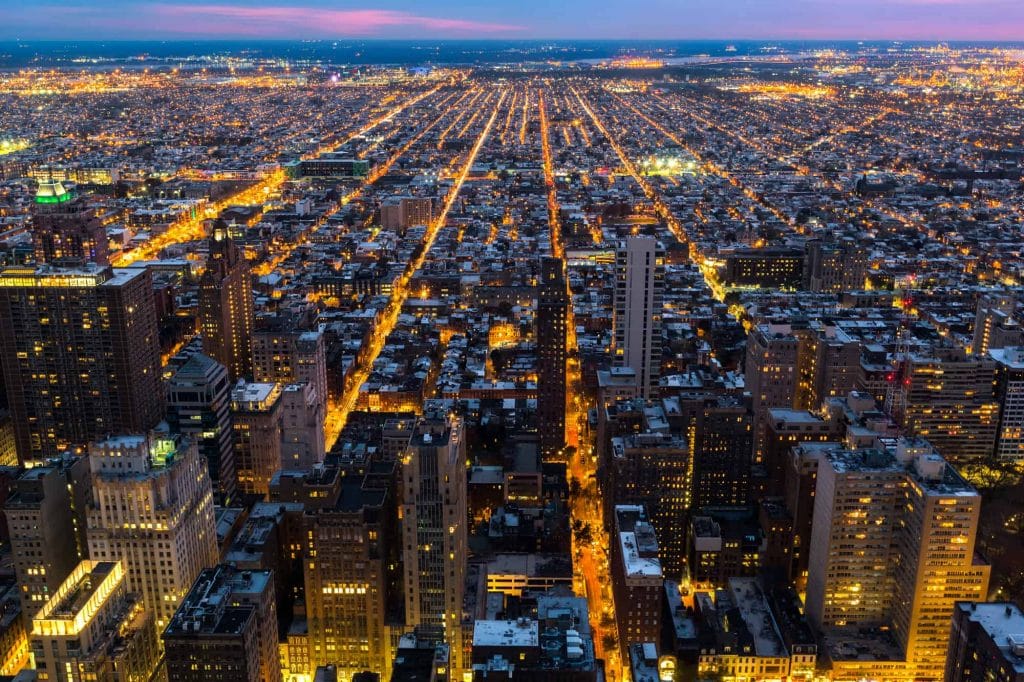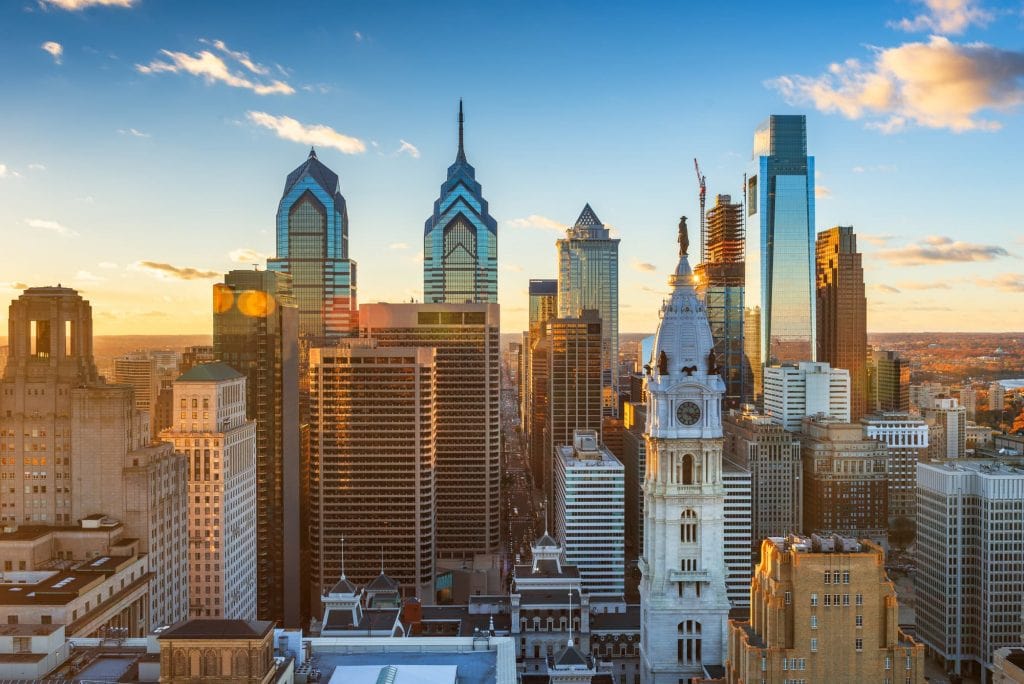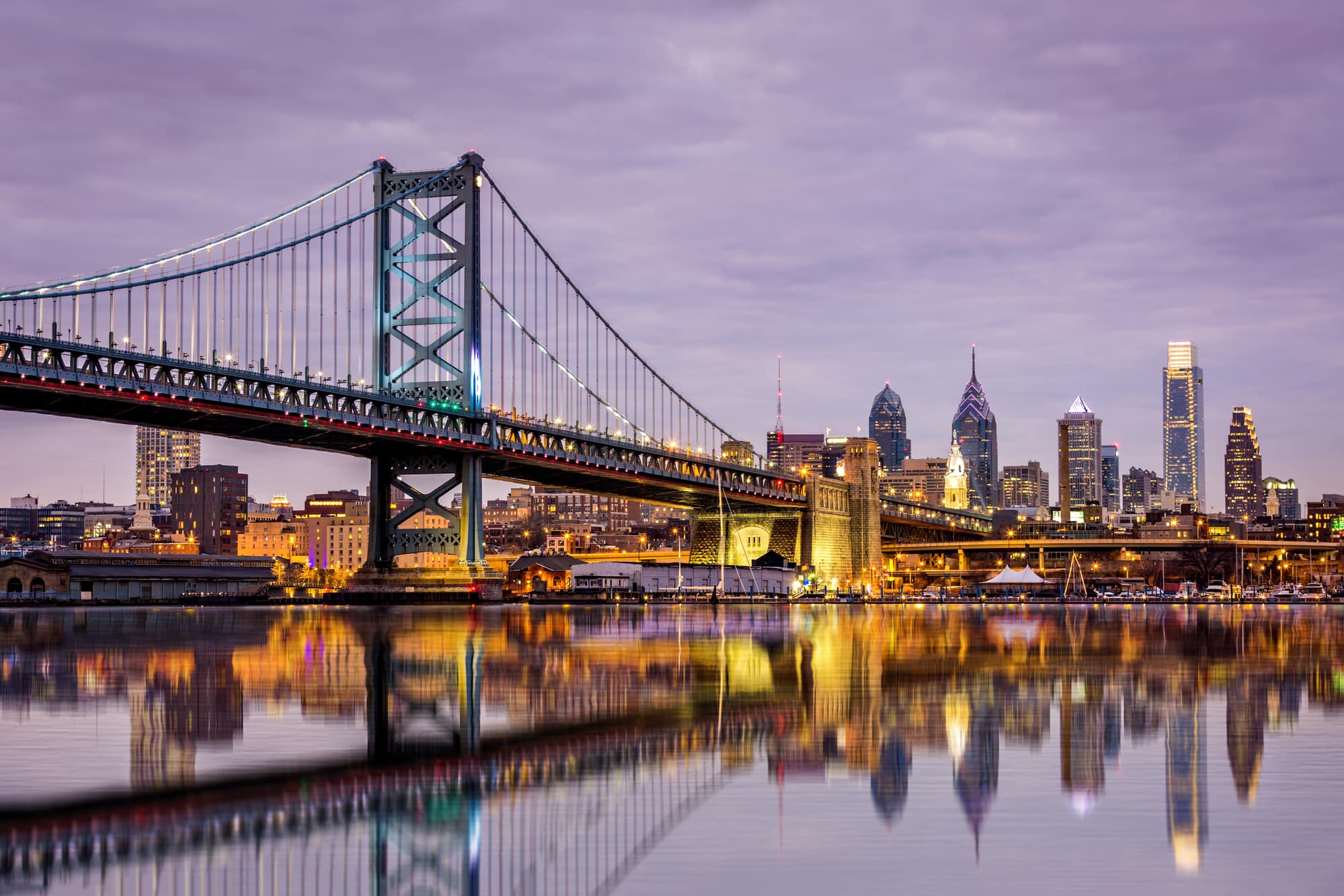Are you thinking about moving to Philadelphia? That’s not surprising. The vibrant, bustling city is steeped in history and culture, offering an exceptional mix of residential neighborhoods, modern conveniences, iconic landmarks, and diverse culinary delights. With its rich arts scene, lively sports culture, and proximity to nature, Philadelphia has something for everyone.
Philadelphia is the largest city in Pennsylvania and the sixth-most populous city in the United States. It is also the birthplace of American independence, so naturally, Philly is defined for its rich history and abundant museums and landmarks.
If all of that resonates with you and you want to know more about the City of Brotherly Love before exploring some Philadelphia homes for sale, read on to learn everything you need about this beautiful city.
Your Complete Guide To Moving to Philadelphia
This guide will give you all the essential insights about relocating to Philadelphia, from lifestyle, cost of living, housing market to education, culture, and more. Here’s what we’ll be discussing:
- Why Philadelphia is a great place to live
- Understanding Philadelphia’s complex housing and rental market
- Exploring different neighborhoods and their unique appeal
- Living cost, education, job opportunities, and the cultural scene in Philly
Here is your go-to guide on all things Philly. So stay with us to get all the information you need to make an informed decision.
Choosing Philadelphia and a Lifestyle
Philadelphia is an exciting place to live with everything you want in a city, from rich history to diverse culture to delicious cuisine and more. Center City is home to Independence Hall, where the Declaration of Independence and Constitution were signed.

The city is also famous for the Liberty Bell, an iconic symbol of American independence, housed in the Independence National Historical Park. Besides its historic appeal, Philadelphia has an impressive food scene, too. Iconic Philly Cheesesteak and soft pretzels? Yes, please!
But this city is more than history and delicious eats. Its vibrant arts and cultural scene includes the Philadelphia Museum of Art, known worldwide for its extensive collection.
What’s more, many outdoor spaces here, including the largest landscaped urban park in the world, Fairmount Park, and the Spruce Street Harbor Park along the Delaware River, feature tons of recreational opportunities.
Rental and Housing Market in Philadelphia
Philadelphia is known for its variety and affordability compared to other major cities on the Eastern Seaboard. Historic row houses, high-rise apartments, and single-family homes characterize the city’s housing market.
Real Estate
On average, housing costs in Philadelphia are significantly lower than in other northeastern cities. Whether you’re seeking a residential street in a quiet suburb or the buzz of city life in a high-rise apartment in Center City, Philadelphia’s real estate market has something for every lifestyle and budget.
Rentals
The rental market in Philadelphia is just as diverse as the real estate market. Depending on the neighborhood, you can find everything from budget-friendly studios to one-bedroom apartments to upscale two-bedroom units in luxury buildings.
Trendy Neighborhoods in Philadelphia
Philadelphia is known for its distinct neighborhoods, each offering a unique charm. University City is a lively neighborhood in West Philly, home to several prominent universities, including the University of Pennsylvania and Drexel University. While the Northern Liberties, a former industrial hub, is now a trendy area known for its music venues, art galleries, and eateries.
Fitler Square offers a blend of city living with a touch of green spaces and community gardens, while the historic neighborhood of Logan Square features stunning architecture and proximity to the city’s top attractions. Finally the northeast Philadelphia area has affordable housing, excellent public schools, street parking, and family-friendly amenities for those seeking a more residential area.
Transportation and Traffic

Navigating Philadelphia is straightforward, thanks to its comprehensive public transportation system and city layout. The Southeastern Pennsylvania Transportation Authority (SEPTA) operates an extensive network of buses, subways, and trolleys, making commuting easy, even for those outside the city center. Bus routes are widespread, connecting various neighborhoods and extending into suburban areas.
The city is also known for its bike-friendly streets, and with the Indego bike-sharing program, getting around is a breeze. Despite its size as one of the largest cities in the U.S., Philadelphia boasts a grid-like street layout, making it one of the most pleasant cities to walk and wander in the northeast.
Education Hub
When it comes to education, there are tons of options in Philadelphia. The School District of Philadelphia oversees the city’s public schools, serving over 130,000 students in more than 200 schools. The city is known for its commitment to improving education standards, with many public schools having excellent ratings.
Philadelphia is home to several top-ranking institutions for post-secondary education, including the University of Pennsylvania, Temple University, and Drexel University. These schools offer a variety of programs, including renowned business and medical schools, attracting students from all over the country and beyond.
Philadelphia also boasts a vibrant cultural scene, with many museums, theaters, and festivals that enrich the learning experience of students and residents alike. From the Franklin Institute to the Kimmel Center, there is always something new and exciting in the City of Brotherly Love.
Kid-Friendly Zones
Philadelphia is an excellent city for raising a family, thanks to its kid-friendly areas that feature fantastic schooling options, parks, and amenities. Neighborhoods like Chestnut Hill and Mount Airy are known for their excellent public schools, safe streets, and family-oriented community events. Fairmount Park, the city’s largest green space, offers numerous playgrounds, walking trails, and picnic areas perfect for family outings.
In addition, Philadelphia’s wealth of historical sites, such as Independence Hall, the Liberty Bell, and the Philadelphia Museum of Art, provide children with educational and entertaining day trip options.
Job Market and Economy: Taxes

Philadelphia’s job market is as diverse as the city itself. It’s a hub for several industries, including healthcare, education, and financial services. The city has several Fortune 500 companies, including Comcast, Crown Holdings, and Aramark, providing many job opportunities.
When it comes to taxes, Philadelphia has a unique structure. It is the only city in Pennsylvania that levies its income tax. The city wage tax is on salaries, wages, commissions, and other compensation. While the tax rate can seem high compared to some other cities, it’s essential to balance this with the city’s lower cost of living than other major metropolitan cities.
In addition to the city wage tax, Philadelphia residents also pay federal, state, and local taxes. The federal income tax rate varies depending on income level and filing status. The state income tax rate is a flat 3.07%.
The local earned income tax rate is 1% for residents of Philadelphia and 0.5% for non-residents who work in the city. These taxes are deducted from paychecks by employers or paid quarterly by self-employed individuals.
Diversity, Culture, and Population Stats
Philadelphia is diverse and vibrant, with a population representing various ethnic and cultural backgrounds. Philadelphia is home to over 1.5 million people, and its rich history is a prominent aspect of its cultural identity. Known as the ‘Birthplace of America,’ Philadelphia played an essential role in the American Revolution.
Independence Hall, where the Declaration of Independence and the US Constitution were signed, and the Liberty Bell, an enduring symbol of American freedom, are major attractions for history buffs.
There are a variety of museums, including the African American Museum, American Jewish History Museum, and Betsy Ross House. With their cobblestone streets and 18th-century buildings, Philadelphia’s historic neighborhoods add a unique charm to the cityscape.
Better Cost of Living
Despite being one of the largest cities on the Eastern Seaboard, Philadelphia offers a comparatively lower cost of living. That extends to various aspects of daily life, from housing costs to groceries.
For instance, a two-bedroom apartment in Philadelphia is generally cheaper than in other major cities like New York or Washington, DC. Here are some compelling reasons Philadelphia’s cost of living is appealing:
- Affordable Housing: Philadelphia’s rental and housing markets offer more affordable options than other major northeastern cities.
- Lower Healthcare Costs: Philadelphia’s healthcare costs are generally lower than the national average.
- Inexpensive Public Transportation: SEPTA offers affordable options for commuting within the city.
This affordability makes Philadelphia a desirable destination for individuals and families looking for inexpensive urban living.
Amenities and Green Spaces

Philadelphia is renowned for its abundance of amenities and green spaces. The city’s vibrant food scene is famous for iconic foods like cheesesteaks and soft pretzels, and neighborhoods like Northern Liberties and Center City are bustling with restaurants, bars, and shops. Spruce Street Harbor Park and Washington Square are popular outdoor dining and relaxation spots.
The city boasts one of the largest urban park systems in the world, with Fairmount Park serving as its crown jewel. The park spans over 2,000 acres and offers miles of trails, athletic facilities, historic buildings, and the Philadelphia Zoo. Additionally, numerous neighborhood parks and community gardens dot the city, ensuring that no matter where you live, a touch of nature is never far away.
Thriving Art and Music Scene
Philadelphia’s art and music scene is as diverse and vibrant as the city. The city is home to world-class museums, including the Philadelphia Museum of Art, famous for its impressive collection of American, European, and Asian art. Don’t forget to take the iconic run up the museum’s steps, immortalized by Sylvester Stallone in the “Rocky” movies.
Art lovers should also visit the Magic Gardens, a mosaic art environment that spans half a city block. For a touch of historical art, head to Christ Church to admire its stunning architecture.
The city’s live music venues, like Johnny Brenda’s, are famous for showcasing local talent and hosting international acts. At the same time, music festivals like the annual Made in America Festival add to its thriving music scene.
Eating Out
Eating out in Philadelphia is an adventure in itself. The city offers various dining options, from high-end establishments to hole-in-the-wall eateries. Perhaps the best thing about Philly’s food scene is its iconic cheesesteak.
South Philly institutions Pat’s King of Steaks and Geno’s Steaks are two rival establishments that claim to make the best cheesesteak in town. A trip to Reading Terminal Market will introduce you to various cuisines, from Amish baked goods to Greek fare. Also, remember to try the soft pretzel, a beloved Philly snack.
Seasonal Impact
Philadelphia experiences all four seasons, each adding charm to city life. Spring and fall are generally mild and beautiful, with parks and gardens in full bloom. Summer can be hot, but it’s also the season for outdoor concerts, beer gardens, and Spruce Street Harbor Park trips.
Winter can be a mix of mild to severe, with snow affecting traffic and daily routines. However, the city is well-equipped to deal with snow. Despite the cold, winter brings the charm of holiday decorations and festive events.
Strange Laws and Other Unique Philly Facts
Like many old cities, Philadelphia has its share of unique laws and quirks. For instance, it is against the law to put pretzels in bags in Philadelphia. Sounds strange, right? But that’s part of the city’s charm.
Another unique fact about Philly is its liquor laws. Wine and spirits can only be purchased at state-owned stores, and beer is primarily sold at bars, delis, and dedicated beer distributors. While this might seem odd to newcomers, Philadelphians have adapted to these peculiar laws.
Regarding crowd sizes, Philadelphia is known for its passionate and dedicated sports aficionados. From the Eagles in the NFL to the 76ers in the NBA, the Phillies in the MLB, and the Flyers in the NHL, sporting events regularly draw large crowds, making the city’s stadiums some of the most thrilling places to experience a game.
FAQs: Moving to Philadelphia
Get the answers to the most frequently asked questions about moving to Philadelphia and understand what living in the city entails.
Why should I move to Philadelphia?
Philadelphia has a rich history, diverse culture, thriving arts, and a vibrant food scene. It offers an affordable cost of living compared to other major northeastern cities and a mix of urban life with ample green spaces, making it an ideal place to call home.
Is Philly a nice city to live?
Yes, Philadelphia is an excellent city to live in, offering a balance of historic charm and modern amenities. Moreover, it is home to friendly neighborhoods, top-tier educational institutions, and a vibrant arts and food scene.
What is a livable salary in Philadelphia?
The livable salary in Philadelphia can vary greatly depending on lifestyle and personal circumstances. However, the median household income in Philadelphia is about $45,927, according to the American Community Survey.
What is the nicest suburb of Philadelphia?
There are several appealing suburbs of Philadelphia. Places like University City and Fitler Square are particularly popular due to their residential charm, excellent schools, and proximity to the city center.
Is Philadelphia a walkable city?
Yes, Philadelphia is considered a highly walkable city. Its compact downtown, known as Center City, is particularly pedestrian-friendly.
Does Philly feel like a big city?
While Philadelphia is the sixth largest city in the US, it often feels more like a collection of neighborhoods. Each neighborhood has its unique charm and character, giving residents a sense of small-town community within the larger city.
Does it snow in Philadelphia?
Yes, it does snow in Philadelphia, typically from December through February. However, the city is well equipped to handle snowfall and rarely comes to a halt due to winter weather.
Relocating to Philadelphia Conclusion
Philadelphia is an enriching city full of culture and American history. The thriving arts scene, unique food offerings, and diverse neighborhoods make it a great choice for anyone considering a move.
If you’re interested in exploring housing options in Philadelphia, start your home search with us. You can also sign up for daily and weekly updates to be the first to see new listings in the market. Once you find your dream home, contact a local eXp agent to begin your homeownership journey in Philly.





